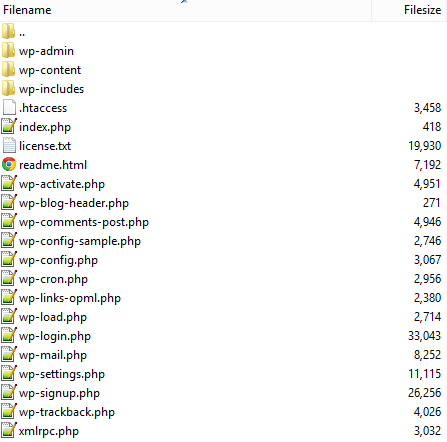What the heck is FTP and why should I care?
FTP stands for File Transfer Protocol, but let’s not worry too much about the name.
Your WordPress site is composed of files. There are files for:
- The main WordPress installation.
- Your theme.
- Every single plugin.
- Everything you upload (images).
Those are all files and they’re all stored on the server you pay for. If you go to Appearance » Editor or Plugins » Editor you can see some of those files because WordPress allows you to edit the theme and plugin files from inside the admin panel.
Have you ever edited your theme/plugin file (maybe to add something to the functions.php file), then gotten the white screen of death? You try to access your blog and all you get is a blank white screen with some confusing message about a syntax error. Has that ever happened to you?
If it has, it’s because you mistyped something in the file. You may have missed off a bracket, a semi-colon, a parenthesis, or messed it up in a more major way. Sometimes, you may even know how to fix it. The error tells you exactly where the problem is. You may realize, “D’oh! I forgot that semi-colon. I just need to add it in and all will be well again.” But, since the error is there, you’re locked out of WordPress and have no way to fix the problem!
This is where FTP comes in.
FTP is a better way for you to access and edit those files
FTP allows you to connect to your server through an application on your computer. When you’re connected, you have access to all the files! You can see the WordPress files, navigate to the theme/plugin files, and you can even browse through all your images. You can then download and/or edit any file of your choosing, then re-upload it.
The benefit to using FTP instead of the WordPress editor is that you can fix mistakes. If you edit something in FTP, re-upload the file, then get the white screen of death, no problem! All you have to do is edit the file once more (you don’t lose your FTP connection), fix the problem, and re-upload the file. Problem solved! You won’t get locked out of FTP like you can get locked out of WordPress.
Jolly good! Now how do I use this FTP?
Even if you don’t edit files often, it’s still a good idea to learn how to use FTP just in case. I’ll walk you through it!
First, download FileZilla
FileZilla is an application you can install onto your computer. This is your FTP client. Whenever you want to connect to your site through FTP, you open up FileZilla. To download it, just visit the FileZilla website and download the FileZilla Client (NOT the “Server”).
Open it up and add your details
Once you have FileZilla downloaded, open it up. At the top of the screen, you’ll see a bar that looks like this:
You have to fill out the Host, Username, and Password boxes (you can leave Port blank).
Host is super easy. It’s just ftp.yourdomain.com. So for me it would be ftp.nosegraze.com
Username and password are a little trickier. If your host comes with cPanel installed, try entering your cPanel username and password. That should probably work. If it doesn’t, you may have to reset your password or create a new FTP account. You can do this by logging into cPanel with your host and navigating to the FTP Accounts section. That’s where you can set up a new FTP user. Just make sure that you remove the username from the “Directory” box. By default it tries to add the new username onto the end, but you want to remove that. I’m sorry I don’t have any screenshots for this part but I don’t have cPanel so I can’t take any screenshots. 🙁
Once you have your username and password, enter them into the box and press Quickconnect.
Understanding the windows
Your FileZilla screen is split up into two halves: the Local Site half (on the left) and the Remote Site half (on the right).
The local site is just your computer. It shows the files and folders on your computer (like your Desktop, Documents, etc.).
The remote site shows your server. These are all the files stored with your web host.
Navigating through the files
After you’ve connected, check the Remote Site half on the right. You should see files that look like this:
If you DON’T see this, look for a folder called public_html. Click/highlight that and press “Enter” to go into it. Now you should see the wp-{name} files/folders.
Those files are WordPress files! See how they’re all prefixed with wp- ? What you see at first are the core WordPress files, but we can navigate into the theme/plugin files too.
Finding the theme/plugin files
To find those, double click on the wp-content folder to open it. You should now see some new folders, including:
- plugins
- themes
- uploads
I think those are each self explanatory. 😉 So if you double click on themes, you’ll be taken to the folder that contains all the themes. Each theme then has its own folder, so you can double click on that to enter it.
How to edit files in FTP
The whole point of this was to teach you how to better edit files, so let’s go over that!
First navigate to a file that you want to edit. So you might go to wp-content/themes/twentyfourteen/. That’s the folder for the WordPress Twenty Fourteen theme. Then right click on one of the files, like functions.php. You’ll have a bunch of right-click options, including two important ones:
- Download
- View/Edit
Downloading files
If you click Download, it will download that file into wherever you are on the Local Site side of the screen. So if the local site side is currently showing your “Desktop”, then the file will be downloaded to your desktop. If the local site side is showing your “Documents” folder, the file will download to Documents. So make sure you’re located in an easy-to-access place before downloading the file.
Once it’s downloaded, you’ll have a copy of the PHP file on your computer. Now you can open it up with your favourite text editor (like TextWrangler for Mac or Notepad++ for Windows) and make changes.
Once you’re done, you can upload the new copy of the file by going back to FileZilla. You should now see the local copy of the file on the local site side (left). Simply right click it and select “Upload”. When asked if you want to overwrite the file, say yes. That just means you’ll be replacing the one on the server with your local copy.
Editing files
There is a slightly quicker way to edit files and that’s by selecting the “View/Edit” option instead of “Download”. Doing this will automatically download the file to your computer (temporarily) and open it in your default text editor. This all happens by itself when you click “View/Edit”. The text editor will immediately open with the file inside it. Then you can make changes, Save, swap back to FileZilla, and it will come up with a message asking you if you want to upload the file back to the server. Yes you do!
Some cautionary words
I hope all this goes without saying, but I feel obligated to cover it anyway… Be careful when using FTP! You wouldn’t go to Appearance » Editor inside WordPress, delete all the code in the boxes, and Save, would you? Of course not! So, similarly, don’t go into FTP and start deleting files. Those files are what make up your blog/WordPress installation. Deleting them could ruin your site!
- Be careful clicking around. Don’t accidentally move/delete files.
- When making changes, be mindful of what you’re doing. If you’re not super familiar with code, it’s a good idea to take a backup of the file before you make changes to it. You can do this by download the file, duplicating it (to save a copy), then make changes to the original. But you always have the copy to revert back to just in case!



Thanks again for the info!
No problem. 🙂
I had no idea about any of this (surprise surprise lol), but I’m bookmarking this post and I’ll have to look into the whole FTP thing more 🙂 Thanks for the info!
My pleasure! 😀
Great article 🙂 I almost never uses the built-in editor in WP because I usually make changes on my computer and when I’m happy with it, I upload it via FTP. I’m not doing this for MapleBooks, but I usually like using Git. I make your changes locally and when I’m done I can just push everything “in production” in one command line. That way, I don’t have to remember which files I modified.
Fantastic! Git is an excellent resource! 🙂
Everytime i read your tutorials i get closer and closer to migrating to word press! I think it might need to happen very soon.
Oh goodie!! 😀
Thank you so much for this post! I’ve been trying to figure out how to use FTP forever and couldn’t find a good guide anywhere. This rocks!
You’re welcome! 😀 Let me know if you have any questions!
Lol the white screen of death scared the crap out of me the first time I saw it. I was like AHHH EVERYTHING IS BROKEN D:
Really though, It would be great if WordPress could add some sort of syntax checker to prevent bad submits. Going in through FTP is a pain sometimes 😛
Perfect, thanks so much! This is really helpful. I do have the white screen of death on one of my websites right now. Thankfully it’s not my blog, but a website I did for my mum, but it’s really weird since I haven’t even been using it lately and I made no changes whatsoever. I was really suprised when I couldn’t even log into the dashboard! Anyways, I’ll figure it out, this is great. 🙂
Thank you for this straightforward and helpful description! You helped me get back into my website after I broke it this morning 🙂
Hi Ashley,
Thanks for sharing this tutorial. I messed up with my function.php file. Took me over an hour to figure things out and set it back.
I’m glad I found this article at the right time 🙂
Keep sharing, Ashley!
-Favour
Ashley, this post just saved me. I build very simple template-based wordpress websites with some success, but they I went and took a coding course and decided to mess with the functions.php file. I completely broke my site. Thanks to you, I was able to fix it. You seriously saved me. Thank you soooooo much!
When I ftp a file up, it is changed in the wordpress editor, but when I reload the site it is not changed. The code isn’t changed because I inspected the file, and it’s still the old file. I cleared my cookies, and also tried opening the site in incognito and it still won’t change. 🙁 Any ideas?
This just saved my life! Thank you so so so much for the helpful explanations!!!
Helped me a lot. Thanks!
I dont have CPanel to create FTP account,
And that doesnt support linux mint as well,
I am creating wordpress website
So my IP is my website address,
I need to use filezilla to edit some files in my wordpress theme,
Is there any way to get FTP account for filezilla to edit theme php files?
Thank you Thank you Thank you. I needed to tweak the church’s site and your site has empowered me to do so!